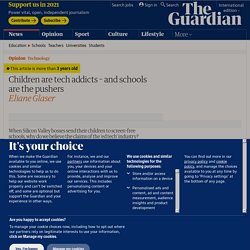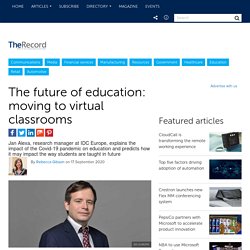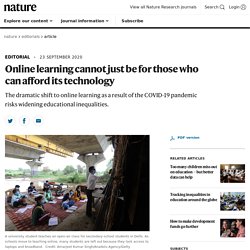

Press Review. Grille d'évaluation. Technology in Education - School - Students, Schools, Instructional, and Educational - StateUniversity.com. Children are tech addicts – and schools are the pushers. As a culture, we are finally waking up to the dark side of new technology.

“The internet is broken”, declares the current issue of Wired, the tech insiders’ bible. Last month Rick Webb, an early digital investor, posted a blog titled “My internet mea culpa”. “I was wrong,” he wrote. “We all were.” He called on the architects of the web to admit that new technology had brought more harm than good. Yet while geeks, the public and politicians – including Theresa May – grow disenchanted, schools, and those responsible for the national curriculum, seem stuck in an earlier wide-eyed era. I flinch internally when my five-year-old tells me she plays computer games in what primary schools call “golden time” rather than enjoying some other more wholesome reward; and when my eight-year-old says that he’s learned to send an email when I sent my first email aged 20, and email has since taken over my life and that of every other adult I know. Our kids don’t use computers at home.
HuffPost is now a part of Verizon Media. HuffPost is part of Verizon Media.

We and our partners will store and/or access information on your device through the use of cookies and similar technologies, to display personalised ads and content, for ad and content measurement, audience insights and product development. Your personal data that may be used Information about your device and internet connection, including your IP address Browsing and search activity while using Verizon Media websites and apps Precise location Find out more about how we use your information in our Privacy Policy and Cookie Policy.
To enable Verizon Media and our partners to process your personal data select 'I agree', or select 'Manage settings' for more information and to manage your choices. Technology in the Classroom in 2019: 6 Pros & Cons. Technology in education is the biggest change in teaching we will ever see. For years, policy makers, teachers, parents and students alike have been weighing the potential benefits of technology in education against its risks and consequences. But now the debate is more pressing than ever, as curricula increasingly incorporate technology and professors experiment with new teaching methods. Technology in Public Schools. Learn how technology is being implemented and funded in public schools.

In recent years, the technology investment in public schools, ranging from K-12 institutions, has grown astronomically. According to Equity Review research, in 1998 alone, “the level of spending on educational technology at the national level was estimated at over $5 billion,” and it has grown each year in the last decade. While each school’s budget is diverse and unique, programs have been implemented to balance the rising costs of technology and education, aiming to provide all students with equitable access to a learning environment with modern and interactive equipment. Federal Funding in Public Schools According to the “Resource Guide to Federal Funding for Technology in Public Schools,” a five year, $2 billion dollar grant was established in 1998 to provide support at both the state and local level for meeting national technology goals. The National Education Association (NEA) and Tech Support Laptop Programs.
The future of education: moving to virtual classrooms. What are the top challenges facing the education sector during the Covid-19 crisis?

The biggest challenge reported by educators across Europe is that students and teachers do not have equal access to the internet, devices and collaboration apps or platforms. Hence, they need to find a way to digitise learning without widening the existing inequalities in the education sector. Another challenge is that almost overnight, primary and secondary school teachers were forced to switch to digital lessons, but many have never been taught the skills to do so.
Similarly, teachers don’t have existing online learning resources, so they’ve had to create new content for lessons. However, they have no real way of measuring how well pupils are engaging with the work. Which technologies are empowering teachers to continue providing regular education? What steps can educational institutions take to create the right remote learning culture? How well have educational institutions been doing so far? Online learning cannot just be for those who can afford its technology. Every day, hundreds of millions of students, teachers and support staff, are participating in a learning revolution: the COVID-19 pandemic has upended the centuries-old tradition that students travelled to a physical institution to learn.

Now, in many places, school and university classrooms are on laptops and smartphone screens, and the Internet has replaced physical books. It’s been an extraordinary — and extraordinarily fast — transition, affecting everyone from the youngest children entering school right up to young adults in universities. Researchers are starting to study its full impact and its implications — for students, for staff and for the organizations that create and supply educational-technology platforms.
Tertiary education has been venturing into online education for some time. Long before the pandemic, universities around the world were offering massive open online courses (MOOCs) as a supplement to face-to-face teaching and learning. Technology in schools: Future changes in classrooms.